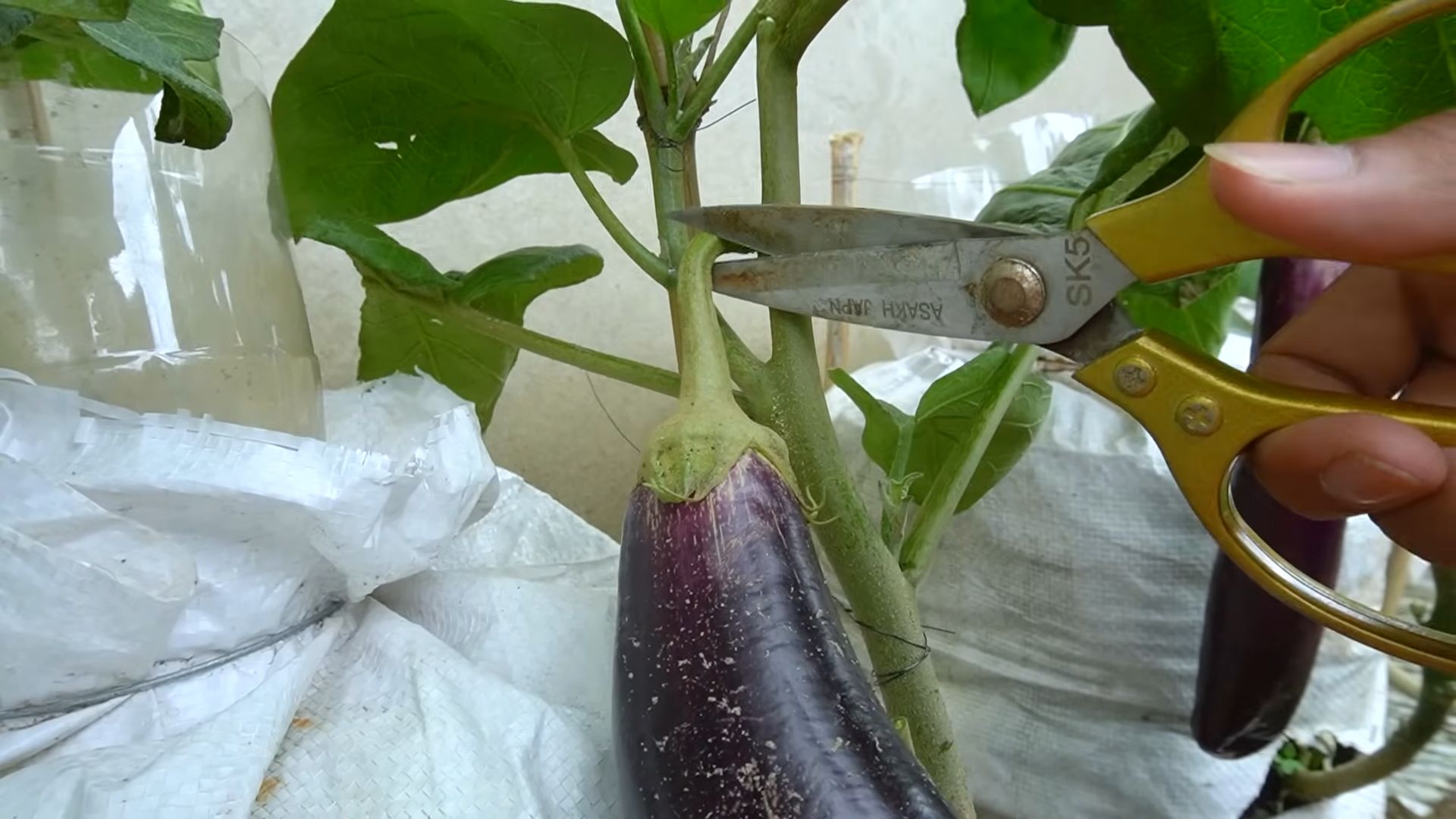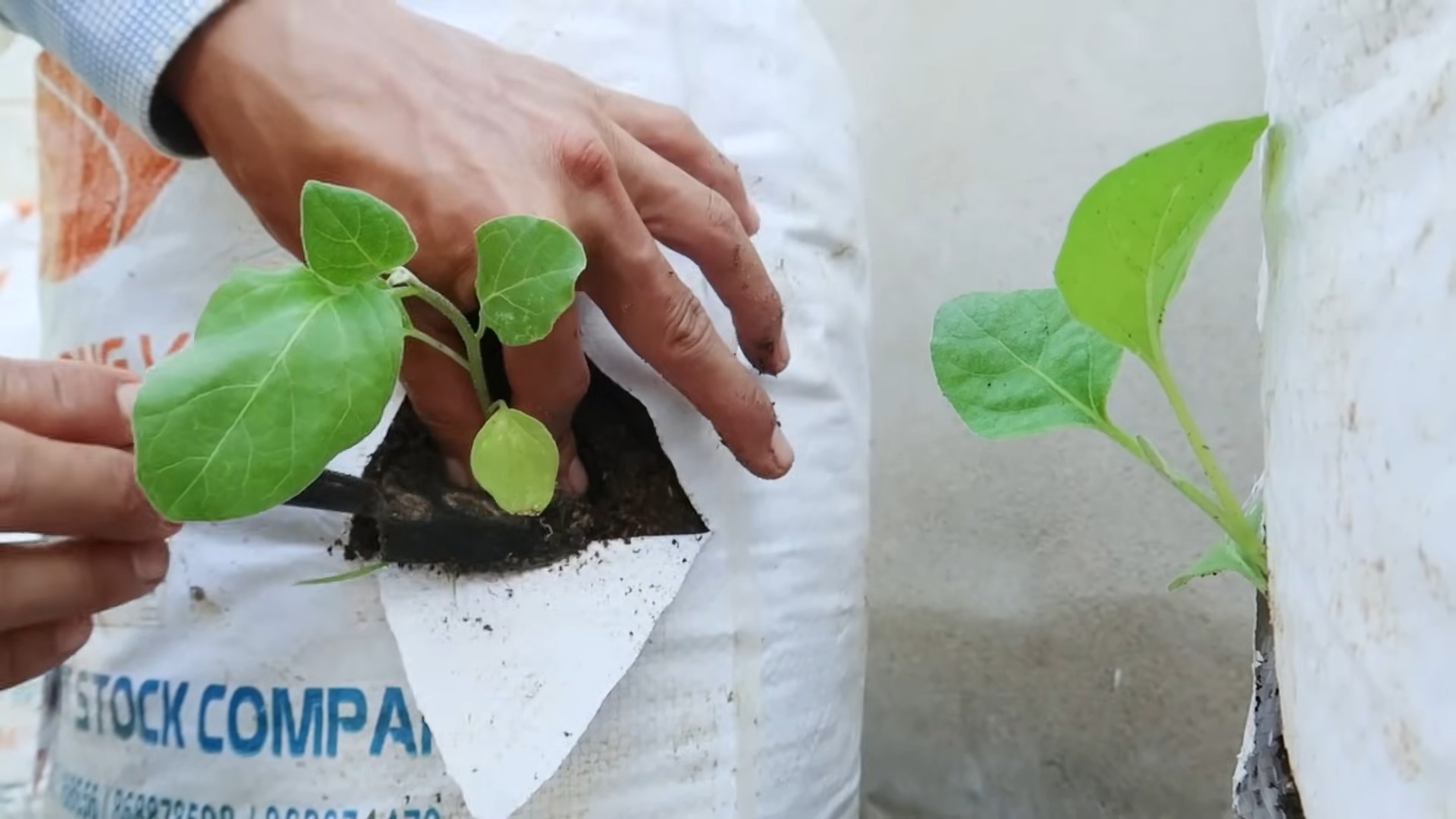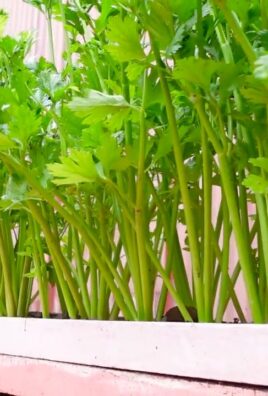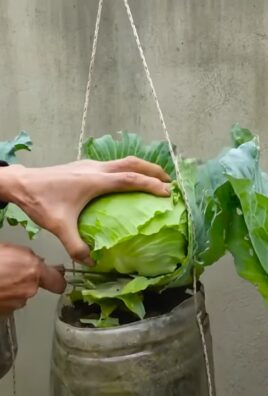Growing Eggplants at Home can seem daunting, but trust me, with a few clever tricks and a little DIY spirit, you can be harvesting your own glossy, purple beauties in no time! Forget those bland, overpriced eggplants at the grocery store – imagine the satisfaction of serving up a dish made with produce you nurtured from seed to table.
Eggplants, also known as aubergines, have a rich history, dating back thousands of years to ancient Asia. They were initially cultivated for medicinal purposes before becoming a culinary staple. Different cultures have embraced the eggplant in countless ways, from the creamy baba ghanoush of the Middle East to the hearty moussaka of Greece. Now, it’s your turn to add your own chapter to the eggplant’s story!
Why should you embark on this DIY adventure? Well, for starters, homegrown eggplants taste infinitely better than store-bought ones. Plus, you have complete control over what goes into your garden, ensuring you’re growing healthy, organic food for yourself and your family. In this article, I’m going to share some simple yet effective DIY tricks and hacks that will make growing eggplants at home a breeze, even if you’re a complete beginner. Get ready to roll up your sleeves and transform your garden into an eggplant paradise!

Growing Eggplants at Home: A Beginner’s Guide
Okay, so you want to grow eggplants? Awesome! I’m here to tell you, it’s totally doable, even if you’re a newbie gardener. Eggplants, with their glossy, deep purple (or sometimes white, green, or even striped!) fruit, are a rewarding addition to any garden. They do need a little TLC, but trust me, the taste of a homegrown eggplant is worth the effort. Let’s dive in!
Choosing Your Eggplant Variety
First things first, let’s talk about eggplant varieties. There are tons to choose from, and the best one for you will depend on your climate, space, and personal preferences. Here are a few popular options:
* Black Beauty: This is a classic, reliable variety that produces large, dark purple eggplants. It’s a good choice for beginners.
* Ichiban: These are long, slender, and dark purple. They mature relatively quickly, which is great if you have a shorter growing season.
* Japanese Eggplant (also known as oriental eggplant): Similar to Ichiban, these are long and slender, but often have a milder flavor.
* White Eggplant: These are, well, white! They have a delicate flavor and are often used in Asian cuisine.
* Fairy Tale: These are small, striped eggplants that are perfect for containers. They’re also quite ornamental.
* Rosa Bianca: A beautiful Italian heirloom with lavender and white striped fruit.
Consider your local climate and growing season when making your choice. Some varieties are more heat-tolerant than others, and some mature faster. Check with your local nursery for recommendations.
Starting Your Eggplant Seeds (or Buying Seedlings)
You have two options here: starting your own seeds or buying seedlings from a nursery. Starting from seed gives you more control over the process and can be more cost-effective, but it requires a bit more time and effort.
Starting from Seed:
1. Timing is Key: Eggplants need a long growing season, so you’ll want to start your seeds indoors about 8-10 weeks before the last expected frost. I usually start mine in late February or early March.
2. Gather Your Supplies: You’ll need seed starting trays or small pots, seed starting mix (not regular potting soil!), a spray bottle, and a heat mat (optional, but helpful).
3. Sow the Seeds: Moisten the seed starting mix and fill your trays or pots. Sow the seeds about 1/4 inch deep and gently cover them with soil.
4. Keep Them Warm and Moist: Place the trays or pots on a heat mat (if using) and cover them with a humidity dome or plastic wrap. Keep the soil consistently moist, but not soggy. Use a spray bottle to mist the soil.
5. Provide Light: Once the seedlings emerge (usually in 7-10 days), remove the humidity dome and place them under grow lights or in a sunny window. If using a window, rotate the seedlings regularly to prevent them from becoming leggy.
6. Thin the Seedlings: If you sowed multiple seeds in each cell, thin them to one seedling per cell once they have their first true leaves (the leaves that look like miniature versions of eggplant leaves).
7. Harden Off the Seedlings: Before transplanting your seedlings outdoors, you’ll need to “harden them off.” This means gradually exposing them to outdoor conditions over a period of about a week. Start by placing them in a sheltered spot outdoors for an hour or two each day, gradually increasing the amount of time they spend outside.
Buying Seedlings:
This is the easier option, especially if you’re short on time or space.
1. Choose Healthy Seedlings: Look for seedlings that are stocky, green, and have no signs of pests or diseases. Avoid seedlings that are leggy or have yellowing leaves.
2. Check the Roots: Gently remove a seedling from its pot and check the roots. They should be white and healthy-looking, not brown and root-bound.
Preparing Your Garden Bed
Eggplants need a sunny spot with well-drained soil. They also prefer slightly acidic soil with a pH of 6.0 to 6.8.
1. Choose a Sunny Location: Eggplants need at least 6-8 hours of sunlight per day.
2. Prepare the Soil: Dig a hole that is twice as wide as the root ball of your eggplant seedling and just as deep. Amend the soil with compost or well-rotted manure to improve drainage and fertility. I like to add a handful of bone meal to the planting hole to encourage strong root growth.
3. Test Your Soil (Optional): If you’re not sure about your soil’s pH, you can test it with a soil testing kit. If the pH is too high (alkaline), you can lower it by adding sulfur or peat moss to the soil.
Transplanting Your Eggplant Seedlings
Once the danger of frost has passed and the soil has warmed up, it’s time to transplant your eggplant seedlings into the garden.
1. Choose a Cloudy Day: Transplanting on a cloudy day will help to reduce stress on the seedlings.
2. Water the Seedlings: Water the seedlings thoroughly before transplanting them.
3. Dig the Holes: Space the seedlings about 18-24 inches apart.
4. Carefully Remove the Seedlings: Gently remove the seedlings from their pots, being careful not to damage the roots.
5. Plant the Seedlings: Place the seedlings in the holes and backfill with soil. Make sure the top of the root ball is level with the surrounding soil.
6. Water Thoroughly: Water the seedlings thoroughly after planting.
7. Mulch: Add a layer of mulch around the plants to help retain moisture, suppress weeds, and regulate soil temperature. I like to use straw or wood chips.
Caring for Your Eggplant Plants
Eggplants need regular watering, fertilizing, and pest control.
1. Watering: Water your eggplant plants deeply and regularly, especially during hot, dry weather. Aim to keep the soil consistently moist, but not soggy. Water at the base of the plants to avoid wetting the foliage, which can lead to fungal diseases.
2. Fertilizing: Eggplants are heavy feeders, so you’ll need to fertilize them regularly. Use a balanced fertilizer (e.g., 10-10-10) every 2-3 weeks. You can also side-dress the plants with compost or well-rotted manure.
3. Staking: As your eggplant plants grow, they may need to be staked to support the weight of the fruit. Use bamboo stakes or tomato cages to provide support.
4. Pruning: Pruning can help to improve air circulation and encourage fruit production. Remove any suckers (shoots that grow from the base of the plant) and any yellowing or diseased leaves.
5. Pest Control: Eggplants are susceptible to a variety of pests, including aphids, flea beetles, and tomato hornworms. Inspect your plants regularly for signs of pests and take action as needed. You can use insecticidal soap, neem oil, or hand-pick the pests off the plants.
6. Weed Control: Keep the area around your eggplant plants free of weeds. Weeds compete with the plants for water and nutrients. Mulching can help to suppress weeds.
Harvesting Your Eggplants
Eggplants are typically ready to harvest about 60-80 days after transplanting.
1. Check for Ripeness: The skin of the eggplant should be glossy and firm. The fruit should be the size and color that is typical for the variety you are growing.
2. Gently Squeeze: Gently squeeze the eggplant. If it gives slightly, it’s ripe. If it’s hard as a rock, it’s not ready yet.
3. Use Pruning Shears: Use pruning shears or a sharp knife to cut the eggplant from the plant. Leave about an inch of stem attached to the fruit.
4. Harvest Regularly: Harvest your eggplants regularly to encourage the plant to produce more fruit.
Dealing with Common Eggplant Problems
Even with the best care, you might encounter some problems while growing eggplants. Here are a few common issues and how to deal with them:
* Blossom-End Rot: This is a common problem that causes the bottom of the eggplant to rot. It’s usually caused by calcium deficiency or inconsistent watering. To prevent blossom-end rot, make sure your soil is well-drained and that you water your plants regularly. You can also add calcium to the soil by adding bone meal or crushed eggshells.
* Flea Beetles: These tiny beetles can chew holes in the leaves of your eggplant plants. To control flea beetles, you can use insect

Conclusion
So, there you have it! Growing eggplants at home might seem daunting at first, but with a little patience, the right knowledge, and this straightforward guide, you’ll be harvesting your own delicious, glossy eggplants in no time. This isn’t just about saving money at the grocery store; it’s about connecting with your food, understanding the growing process, and enjoying the unparalleled flavor of homegrown produce.
Why is this a must-try? Because fresh, homegrown eggplants offer a taste and texture that you simply can’t find in store-bought varieties. The satisfaction of nurturing a plant from seedling to harvest is incredibly rewarding, and you’ll have complete control over the growing process, ensuring your eggplants are free from unwanted pesticides and chemicals. Plus, you’ll have bragging rights at your next dinner party!
But don’t stop there! Experiment with different eggplant varieties. Try growing the classic Black Beauty, the slender Japanese eggplant, or even the vibrant Thai eggplant. Each variety offers a unique flavor profile and texture, adding exciting diversity to your culinary creations. Consider companion planting to enhance your eggplant’s growth. Basil, thyme, and marigolds are excellent choices that can deter pests and attract beneficial insects.
For those in cooler climates, consider starting your seedlings indoors earlier in the season to give them a head start. You can also use row covers to protect your plants from frost and extend the growing season. If you’re short on space, try growing eggplants in containers. Just be sure to choose a large pot (at least 5 gallons) and provide adequate support for the plant as it grows.
We’ve covered the essentials of growing eggplants at home, from seed starting to harvesting, but the real magic happens when you get your hands dirty and start experimenting. Don’t be afraid to try new things, learn from your mistakes, and adapt your approach to suit your specific climate and growing conditions.
Now, it’s your turn! Grab some seeds, prepare your soil, and embark on your eggplant-growing adventure. We’re confident that you’ll be amazed by the results. And most importantly, we want to hear about your experience! Share your tips, tricks, and triumphs in the comments below. Let’s build a community of eggplant enthusiasts and learn from each other. Happy gardening! We are sure that you will love the process of growing eggplants at home.
Frequently Asked Questions (FAQ)
Q: How long does it take to grow eggplants from seed?
A: Growing eggplants from seed to harvest typically takes between 16 to 24 weeks, depending on the variety and growing conditions. Starting seeds indoors 6-8 weeks before the last expected frost can significantly shorten the overall time to harvest. Remember that consistent warmth and sunlight are crucial for optimal growth. Monitor your seedlings closely and provide supplemental lighting if needed, especially in areas with shorter days.
Q: What are the most common pests and diseases that affect eggplants?
A: Eggplants are susceptible to several pests and diseases, including aphids, flea beetles, spider mites, tomato hornworms, and verticillium wilt. Regularly inspect your plants for signs of infestation or disease. For aphids and spider mites, try spraying the plants with a strong stream of water or using insecticidal soap. Flea beetles can be controlled with row covers or diatomaceous earth. Tomato hornworms can be handpicked and removed. To prevent verticillium wilt, choose disease-resistant varieties and practice crop rotation. Good air circulation and proper watering techniques can also help minimize the risk of fungal diseases.
Q: How often should I water my eggplants?
A: Eggplants need consistent moisture, especially during hot weather. Water deeply and regularly, aiming for about 1-2 inches of water per week. Avoid overhead watering, as this can promote fungal diseases. Instead, water at the base of the plant, preferably in the morning. Mulching around the plants can help retain moisture and suppress weeds. Check the soil moisture regularly by sticking your finger about an inch deep into the soil. If it feels dry, it’s time to water.
Q: What kind of fertilizer should I use for eggplants?
A: Eggplants are heavy feeders and benefit from regular fertilization. Start with a balanced fertilizer (e.g., 10-10-10) at planting time. Once the plants start to flower and fruit, switch to a fertilizer with a higher phosphorus content (e.g., 5-10-5) to promote fruit development. You can also supplement with compost tea or liquid seaweed fertilizer every few weeks. Avoid over-fertilizing, as this can lead to excessive foliage growth at the expense of fruit production. Always follow the instructions on the fertilizer label.
Q: When is the best time to harvest eggplants?
A: Eggplants are typically ready to harvest when they are firm, glossy, and have reached their mature size and color. Gently press the skin of the eggplant; if it springs back slightly, it’s ripe. If it feels hard and doesn’t give, it’s likely overripe and may be bitter. Use a sharp knife or pruning shears to cut the eggplant from the plant, leaving a short stem attached. Harvest regularly to encourage continued fruit production. Overripe eggplants can become seedy and less flavorful, so it’s best to harvest them when they are at their peak.
Q: Can I grow eggplants in containers?
A: Yes, eggplants can be successfully grown in containers, making them a great option for gardeners with limited space. Choose a large container (at least 5 gallons) with good drainage. Use a high-quality potting mix and provide adequate support for the plant as it grows. Container-grown eggplants may require more frequent watering and fertilization than those grown in the ground. Place the container in a sunny location that receives at least 6-8 hours of sunlight per day.
Q: My eggplant flowers are dropping off without producing fruit. What could be the problem?
A: Flower drop in eggplants can be caused by several factors, including temperature stress (too hot or too cold), insufficient pollination, lack of water, or nutrient deficiencies. Ensure that your plants are receiving adequate water and fertilizer. If temperatures are consistently high (above 90°F) or low (below 60°F), try providing shade or protection. You can also try hand-pollinating the flowers by gently shaking the plant or using a small paintbrush to transfer pollen from one flower to another.
Q: How can I prevent my eggplants from becoming bitter?
A: Bitterness in eggplants can be caused by several factors, including overripeness, stress, and variety. Choose eggplant varieties that are known for their mild flavor. Harvest eggplants when they are at their peak ripeness, before they become overripe. Provide consistent watering and fertilization to prevent stress. Some gardeners also recommend salting eggplant slices before cooking to draw out any bitterness.
Q: Can I save seeds from my homegrown eggplants?
A: Yes, you can save seeds from your homegrown eggplants, but keep in mind that if you grew hybrid varieties, the seeds may not produce plants that are true to type. To save seeds, allow the eggplants to fully ripen on the plant until they become dull and slightly soft. Cut the eggplant open and scoop out the seeds. Rinse the seeds thoroughly and spread them out on a paper towel to dry completely. Store the dried seeds in an airtight container in a cool, dark place.
Q: What are some good companion plants for eggplants?
A: Several plants make excellent companions for eggplants. Basil helps repel pests and attract beneficial insects. Thyme also deters pests and can improve the flavor of eggplants. Marigolds are known for their pest-repelling properties. Beans and peas can fix nitrogen in the soil, benefiting eggplant growth. Avoid planting eggplants near fennel, as it can inhibit their growth. Companion planting can create a more balanced and thriving garden ecosystem.





Leave a Comment